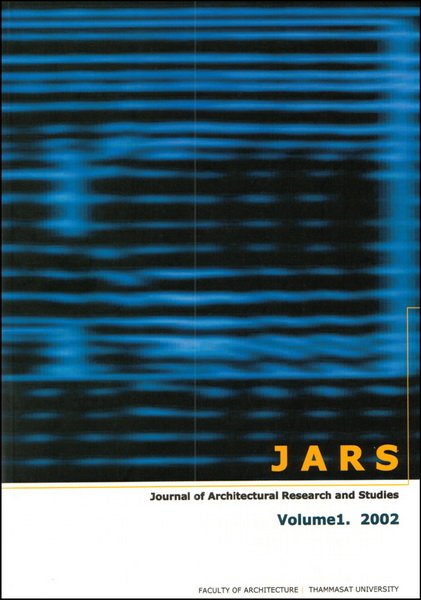Facility Management: Space/Place Management for the Future Environment
Main Article Content
Abstract
In the world of increasingly complex and dynamic variables, the requirement to solve the right problem takes precedence over solving the problem right. Facility Management (FM), the emerging 21th century profession addressing the need of the age focused upon clarity, human understanding and the science of organization of information, is a multidisciplinary or transdisciplinary profession. FM draws on theories and principles of “people”, “processes”, and “places” of organizations rather than serving cost-cutting competencies and downsizing of organizations only. Considering the national crisis, Facility Management is a valid and sustainable remedy as a tool not as the ultimatum. It would be better recognized and gradually accepted to Thai style of working. Through collective reviews and analyzing some concepts of resource management, the requirement of Facility Management within today’s social contexts, and the principles of Facility Management are introduced in this article. A view of rapidly developing professional field of Facility Management is introduced and referred to its related aspects focusing on the concept of today’s workplace and tomorrow’s workspace to arouse public awareness to become more conscious about what is really happening around individuals.
Downloads
Article Details

This work is licensed under a Creative Commons Attribution-NonCommercial-NoDerivatives 4.0 International License.
All material is licensed under the terms of the Creative Commons Attribution 4.0 International (CC-BY-NC-ND 4.0) License, unless otherwise stated. As such, authors are free to share, copy, and redistribute the material in any medium or format. The authors must give appropriate credit, provide a link to the license, and indicate if changes were made. The authors may do so in any reasonable manner, but not in any way that suggests the licensor endorses you or your use. The authors may not use the material for commercial purposes. If the authors remix, transform, or build upon the material, they may not distribute the modified material, unless permission is obtained from JARS. Final, accepted versions of the paper may be posted on third party repositories, provided appropriate acknowledgement to the original source is clearly noted.
References
สุชีลา ตันชัยนันท์. ข้อคิดต่อยุทธศาสตร์แก่วิกฤตชาติ. ทุนนิยมฟองสบู่: ปรัชญาและทางออก.กรุงเทพฯ: บริษัทอมรินทร์พริ้นติ้งแอนด์พับลิชชิ่งจํากัด(มหาชน), 69.
พระธรรมปิฎก(ป.อ. ปยุตโต). (2539). การศึกษาเพื่ออารยธรรมที่ยั่งยืนพิมพ์ครั้งที่3. กรุงเทพฯ: มูลนิธิพุทธรรม, 3.
ยุคศรีอาริยะ. (2544). มายาโลกาภิวัตน์: สงครามเศรษฐกิจยุคไร้พรมแดนพิมพ์ครั้งที่2. กรุงเทพฯ: บริษัทอมรินทร์พริ้นติ้งแอนด์พับลิชชิ่ง จํากัด(มหาชน), 164-166.
Jackson, J. (2000). Value-added service. Evolution. No.4/2000, 4-6.
ชื่นจิตต์ แจ้งเจนกิจ. (2544). การบริหารจัดการในศตวรรษที่21.กรุงเทพฯ: สยามพริ้นท์แอนด์แพ็ค จํากัด.
ไชยรัตน์ เจริญสินโอฬาร.(2542). วาทกรรมการพัฒนา: อํานาจความรู้ความจริงเอกลักษณ์และความเป็นอื่น.กรุงเทพฯ: สํานักพิมพ์วิภาษา, 162.
Lehrer, D. (2000). Sustainable design. Facility design and management handbook (11.1, 11.3). New York: McGraw-Hill Companies, Inc.
Lehrer, D. (2000), 11.2.
เสริชัย โชติพานิช. (2544). เอกสารประกอบการสอนวิชา 2506665 การบริหารจัดการทรัพยากรอาคาร.กรุงเทพฯ: คณะสถาปัตยกรรมศาสตร์ จุฬาลงกรณ์มหาวิทยาลัย, 1.
http://www10.ewebcity.com/busakorn/tifma/study/fm.pdf, 1-3.
Cotts, D. G. (1999). The facility management handbook.New York: Amacom, 7-8.
Cotts, D. G. (1999), 8-9.
Raymond, S., & Cunliffe, R. (1997). Tomorrow’s office: Creating effective and humane interior. London: E & FN Spon, 16-17.
http://www10.ewebcity.com/busakorn/tifma/study/fm.pdf, 8-10.
เสริชัย โชติพานิช. (2541). การบริหารจัดการทรัพยากรอาคาร. อาษาฉบับที่3, 50-60.
วิมลสิทธิ์ หรยางกูร.(2541). พฤติกรรมมนุษย์กับสภาพแวดล้อม: มูลฐานทางพฤติกรรมเพื่อการออกแบบและวาง-แผนพิมพ์ครั้งที่5. กรุงเทพฯ: โรงพิมพ์แห่งจุฬาลงกรณ์มหาวิทยาลัย, 22.
วิมลสิทธิ์ หรยางกูร.(2541), 26.
Lam, A. K. (2000). Business transformation and facility management. Facility design and management handbook (4.1). New York: McGraw-Hill Companies, Inc.
Arnold, J., Cooper, C. L., & Robertson, I. T. (1998). Work psychology: Understanding human behavior in the workplace(3rd ed.). London: Pitman Publishing, 466-477.
http://www.cushwakeasia.com/news/corp_news_release/sg20010925.pdf


